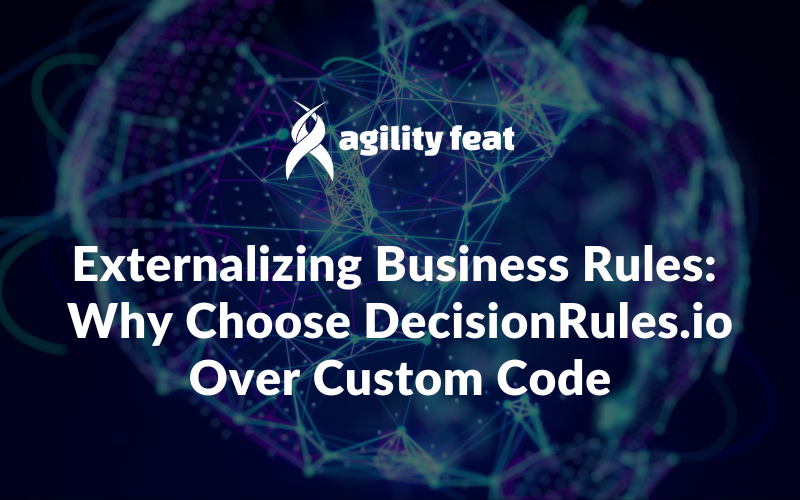“Wave coming, wave coming … paddle! paddle! paddle! Now stand up! Stand up! GET UP!”
I can still hear the voice of my surf instructor, and those lessons provide a great parallel to the growth of my company and yours.
Surfing and Startups in Costa Rica
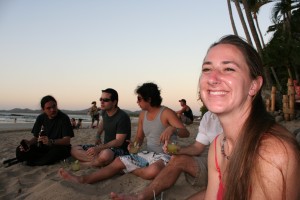 Last week I spent an amazing week with the AgilityFeat development team in Costa Rica. We had almost our whole team of designers, developers, and company leadership together in Tamarindo for a few days at the Tamarindo Diria resort on the Pacific Coast. We called this company event DareToBeLean.
Last week I spent an amazing week with the AgilityFeat development team in Costa Rica. We had almost our whole team of designers, developers, and company leadership together in Tamarindo for a few days at the Tamarindo Diria resort on the Pacific Coast. We called this company event DareToBeLean.
While there, we had three goals:
1. To learn about lean startups and how to be a better entrepreneur from Patrick Vlaskovits, co-author of “The Lean Entrepreneur”.
2. To learn from each other on our team about how to be a better agile software development company, and the lessons we have learned from our clients over the last year and a half of doing nearshore development in Costa Rica for US clients.
3. To celebrate our successes over the last year, and have some fun surfing and snorkeling.
Learning from the Lean Entrepreneur
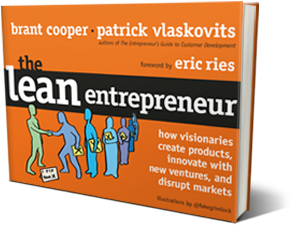 We learned a lot from each other, and had some epiphanies as a team during these few days together in the sun. I’ll blog about many of them over the coming months, but for now I want to focus on the first day of our workshop, which was led by guest speaker Patrick Vlaskovits.
We learned a lot from each other, and had some epiphanies as a team during these few days together in the sun. I’ll blog about many of them over the coming months, but for now I want to focus on the first day of our workshop, which was led by guest speaker Patrick Vlaskovits.
We brought Patrick down from California to work with our team, and for him to share what he has learned from his own experiences as a successful entrepreneur, as well as from the many great entrepreneurs he and co-author Brant Cooper interviewed for their upcoming book the Lean Entrepreneur. It’s a great book coming out in February, and I highly recommend you get it. In fact, if you are one of the first 10 people who read this blog post, and email me at Arin@AgilityFeat.com, then I will give you a digital copy of the book for free.
Customer Segmentation and Passionate Customers
Patrick shared many great things with us, but the one that struck a chord the most was his discussions and exercises around customer segmentation.
That phrase customer segmentation may sound like traditional business plan terminology, but Patrick teaches it in a way that is incredibly powerful, iterative, and lean.
Who are your customers? Traditional segmentation tells consumer companies to think about their customers’ age brackets, gender, and other easily identifiable characteristics. But Patrick taught us to walk through a cycle of how our customer uses our product, and how we can make them truly passionate.
The lifecycle of a passionate customer
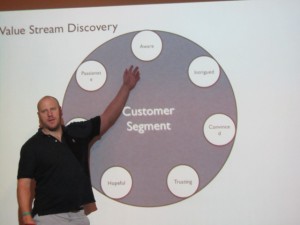 Brant and Patrick have a lifecycle that I’ll quickly summarize here:
Brant and Patrick have a lifecycle that I’ll quickly summarize here:
1. Aware – Customers become aware of your business from an ad or from a friend
2. Intrigued – Something about your pitch catches their interest, and they are intrigued to learn more.
3. Convinced – They are convinced that you can do what you say
4. Trusting – They trust you enough to give you some information about them, sign up for an email list or free trial
5. Hopeful – They begin to use your product and are hopeful that it will solve their problem
6. Satisfied – Your product works as expected, and they are satisfied because you have solved their problem.
7. Passionate – You go the extra mile, or your product causes some unexpectedly great result when solving their problem. Now they become an advocate for you and actively tell others about your product.
Building customer segments
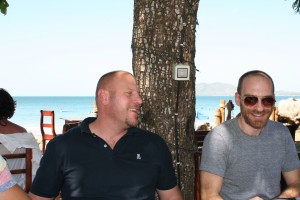 Patrick and Brant go into more depth about this in the book and in their workshops, but basically what we did was brainstorm some customer segments, give them a simple persona, and then walk through how each segment became aware of our product, intrigued, converted to becoming a hopeful customer, a satisfied customer, and then eventually so passionate about what we do that they help bring us additional customers.
Patrick and Brant go into more depth about this in the book and in their workshops, but basically what we did was brainstorm some customer segments, give them a simple persona, and then walk through how each segment became aware of our product, intrigued, converted to becoming a hopeful customer, a satisfied customer, and then eventually so passionate about what we do that they help bring us additional customers.
Walking through this flow can help a startup consider the overall design of their product, as well as the most important parts of the web site or mobile app to build first. It also helps you consider how that flow might be different for your different customer segments.
Anti-segments: You were not made for each other
In the process of this, you should also remember to spend time focusing on anti-segments. These are groups of potential customers that look like your regular customers, and share many of the same characteristics. But as Patrick explained, “in reality, they don’t want you and you don’t want them.“
For example, Patrick told the story about an entrepreneur building a mobile app that helps fresh seafood restaurants price their menu for daily catch items. It turned out there was a whole segment of family run restaurants where the owner was doing this as their semi-retirement job, and they weren’t concerned enough about profits to want this entrepreneur’s app. Sure, there was big potential in the size of that market segment, but it wasn’t worth trying to sell to them. Those restaurants want to turn a profit of course, but they are not so focused on maximizing that profit that they saw value in this extra technology. This is a good example of an anti-segment, which you need to plan to ignore in the development of your product.
Learning to Fall
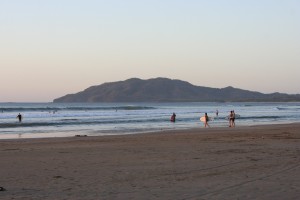 When I was learning to surf last week, the instructors taught me more than just how to get up on the board. They also taught me how to fall down. Because the wind or a wave might catch your board, when you fall off the board, you need to stay underwater for a few seconds, let the board fall, and then come out of the water with your hands covering your head. This is important, because one time I fell and then sprang right back out of the water without covering my head, and there was a loud klunk as the board hit me on the head. It hurt.
When I was learning to surf last week, the instructors taught me more than just how to get up on the board. They also taught me how to fall down. Because the wind or a wave might catch your board, when you fall off the board, you need to stay underwater for a few seconds, let the board fall, and then come out of the water with your hands covering your head. This is important, because one time I fell and then sprang right back out of the water without covering my head, and there was a loud klunk as the board hit me on the head. It hurt.
I’m a big guy, and I don’t think my first instructor Miguel was convinced I could learn to surf. At one point, I was laying on the board as he picked out a wave for me. Miguel said “You’re going to come back and try again, right? You’re not going to give up?”
I was a little surprised by the question, because I didn’t realize I was doing that bad. I had not stood up on the board yet, but I felt I was close, and I had no intention of giving up. I said “of course!” to Miguel, and sure enough, I stood up for the first time on one of the next waves. Miguel was pumping his fist in the air and celebrating even more than I was.
When I was learning to surf, I was prepared to fall more than I stood up. With each fall, my instructors would offer a tip, and I would try to improve my technique and find something that worked for me. Eventually I got it and I caught quite a few waves.
Iterating on your Customer Segments
Your market segmentation should be approached in the same way. What looks good on paper may not work out in the real world. Like any lean startup technique, Patrick was teaching us to iterate. Determine your customer segments and anti-segments. Imagine how those customers approach your product lifecycle, and design experiments to test your assumptions and iterate on your understanding of your customer segments.
I’ve still got a lot to learn about surfing, and I need to iterate on my technique more before I can stand up on the board every time, learn to turn gracefully, and look good for the camera. The same is true for customer segmentation and building a lean startup, but Patrick gave all of us at AgilityFeat another set of great tools last week.





